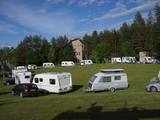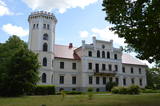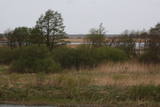| Нo | Название | Описание |
|---|---|---|
|
In the summer season we offer trips by raft and boats, camps for children, an area for organizing events, camping for the night. In the winter season "Baili" has a ski center - downhill ski tracks, ski and snowboard equipment rental, instructor services. Catering offer in a cafe. |
||
|
В биографии К. Валдемара есть известный факт, что летом 1839-го года учителя и ученики Лубэзерской народной школы несколько дней провели на взморье, в поселке Роя, расположенном в 19-и верстах от школы, где позже при посредничестве К. Валдемара была построена мореходная школа. Эта первая встреча с морем произвела на мальчика захватывающее, незабываемое впечатление. «Величественный вид моря так цепко захватил ум юноши, что он все три дня больше ни о чем не думал, как о величественном море, у которого с детской надежностью уже тогда сразу же построил план или проект, каким образом можно было бы на реке Роя соорудить более глубокий порт, в который могли бы входить большие лодки и маленькие корабли» К. Валдемарс. (Источник: Ройский ТИЦ) |
||
|
This is the second thickest tree in Latvia and the Baltic States. There is a large and open hole in the trunk of the tree. Like most trees of its size, it has suffered lightning damage. The tree is a wonderful part of the landscape, and a little wooden fence has been put up around it.
|
||
|
Vermutlich ein heidnischer Hügel. Schöner Blick auf die 6 Seenlandschaften. Ein Symbol vom Nationalpark. |
||
|
Один из крупнейших латвийских виноградников, на котором выращивается более 50 сортов винограда. Хозяин проведет экскурсию с рассказами и даст советы по выращиванию виноградных лоз, организует дегустацию и продажу рассады. |
||
|
Interesantā būve, kurai Baltijas valstīs grūti atrast līdzinieku, ir meklējama 2 km ziemeļaustrumos no Kirblas (Kirbla). 307,8 m garo arkveida tiltu pāri Kazari upei (Kasari jõgi) uzcēla 1904. g. deviņu mēnešu laikā. Tajā brīdī to uzskatīja par Eiropas garāko šāda tipa dzelzsbetona tiltu. Tagad to var šķērsot tikai ar kājām vai ar divriteni. Tumšajā diennakts laikā tilts ir skaisti izgaismots! Tā ievērojamais garums ir skaidrojams ar apstākli, ka pavasara palos Kazari palienes applūst lielās platībā. |
||
|
Celta 1933. g. vietējai brāļu draudzei. Baznīcā atrodas glezna “Kristus” (1850. g.) un Liepājas meistara Jēkaba Jauģieša 1920. g. darinātās ērģeles. Mūsdienās dievnamu izmanto Bārtas draudze. Pie baznīcas novietots akmens apkaimes represētajiem iedzīvotājiem. |
||
|
Кулдигу заслуженно считают красивейшим латвийским провинциальным городом средневековья. На его месте еще до XIII в. находился центр древней земли куршей Бандавас. В 1242 году у водопада Венты Ливонский орден приступил к строительству каменного замка. Рядом с замком образовалось поселение, которое первым (1378 г.) в Курземе получает права города. Важным было и участие города в Ганзейском союзе. В период с 1561 по 1795 гг. Кулдига - столица Курземского герцогства. Закономерно, что в первой половине XVII века город переживает стремительный экономический подъем, который заканчивается с началом Северной войны и эпидемии чумы. Гордость курземчан и недостаток крупных индустриальных объектов является причиной того, почему в советское время город не наводнило большое количество иммигрантов, и поэтому Кулдига до сих пор остается одним из самых латышских городов Курземе. В Кулдигу стоит поехать не на один день. Любители природы могут увидеть летучих рыб, а для исследователей истории культуры здесь приоткрывается всемерно просторное поле деятельности. |
||
|
Находится в южной части Лиепаи. Для ресторана характерна кухня открытого типа, где клиенты могут наблюдать за работой поваров. Латышская кухня: Суп из боровиков, рыбный суп, тонкие блинчики и картофельные блины, отбивная из баранины, приготовленное на гриле свиное филе, язык теленка, приготовленный на пару, баранья ножка, творожная слойка. Особое блюдо: Суп из трески от «Оливе» или особое сладкое пирожное. |
||
|
Karulas nacionālā parka lielākais ezers - 2,8 km garš, līdz 1 km plats. Ezera ziemeļaustrumu krastā atrodas parka apmeklētāju centrs. 5,5 m dziļais ezers ir gan zivīm, gan nostāstiem bagāta vieta. Ezera un tuvākās apkārtnes iepazīšanas nolūkā ir izveidota 3,5 km garā Ehijerva taka (Ähijärve teerada). Tās sākums atrodas pie iepriekš minētā apmeklētāju centra, kur izveidota atpūtas vieta un atraktīvs bērnu spēļu laukums. Taka sākumā ved gar ezera krastu, nelieliem mitrājiem un meža ceļiem, kas izmantoti iepriekšējos gadsimtos. |
||
|
This is a cliff with various levels. Known as the North Estonian cliff, it stretches all along the shore of the Bay of Rīga in Estonia, including some of the local islands. The most expressive part in geological and landscape terms is the Saka-Ontika-Toila cliff, which is around 22 km long and offers an unusual natural environment. The cliff is as much as 53 m high, and it has a fairly virginal forest along its slopes. The layers of clay, sandstone, limestone, etc., come from the Cambrian and Ordovician periods. The Valaste juga (Valaste waterfall) is 24 metres high. After a longer period of freezing temperatures, the waterfall has a particularly impressive appearance. Seasonal waterfalls (8-10 m) can be found near the villages of Ontika and Toila.
|
||
|
Skaistā ēka atrodas Lizuma centrā. Lizuma muižas īpašumi piederējuši dažādām dzimtām – vācbaltiešiem Tīzenhauzeniem, Malamiem un Volfiem. 1836. g. muižu iegādājas barons Otto Gotlībs fon Volfs, kura laikā muižas pils iegūst tagadējo veidolu – Tjudoru neogotikas stilu ar poligonālu torni. Jau no 1937. g. pilī izvietojusies Lizuma skola, kas ir viens no iemesliem, kādēļ saglabājusies ne tikai pati ēka, bet arī atsevišķi interjera elementi kāpņu telpā, Zilajā (Mednieku) zālē u.c. Pili ieskauj parks, kur atrodas muižas saimniecības ēkas – mūra klēts (te kultūras nams), 1876. g. celtais zirgu stallis (sporta halle), kalpu un dārznieka namiņš u.c. Bijušajā spirta brūzī ražo Gotiņas konfektes. Pils tornī izveidots Lizuma vidusskolas veidotais novadpētniecības muzejs. |
||
|
На берегу озера Моосте расположена мыза Моосте. Рядом с красивым главным зданием находится гордость мызы Моосте - величественный приусадебный комплекс, выполненный в стиле историзма. Особое настроение придает мызе парк в английском стиле. В главном здании мызы работает школа, в реновированной бывшей деревообрабатывающей мастерской мызы открыт Гостевой дом усадьбы Моосте, в бывшей конюшне работает мастерская реставраторов, в барском доме - Центр художественной и социальной практики и из бывшего хлева получился концертный зал. |
||
|
Находится около Салацгривского туристического информационного центра в историческом рыбном погребе-леднике. Интерьер выполнен в тематике мореплавания. Латышская кухня: Холодный свекольный суп, суп из морской рыбы, рыбная и овощная запеканка, шоколадная колбаса, блины с клубничным варением, квас. Особое блюдо: Жареная и приготовленная на гриле рыба - окунь, камбала, судак. |
||
|
Находится недалеко от Кулдигской окружной дороги. Деревенский ресторанчик небыстрого обслуживания по принципу слоу-фуд, где блюда готовятся в присутствии клиентов на живом огне (ольховые дрова). Предлагается трапеза в саду. Латышская кухня: Салаты из фасоли, килька с творогом, ячменная каша с копченым мясом, фальшивый гусь, тушеный в сметане судак, треска с луком и помидорами, горшочек с бараниной, луковая отбивная, свиная печень в охотничьем вкусе, тушеные овощи в горшочке, горячий суп с клецками и черникой, латвийские лесные ягоды с взбитыми сливками, карамелизированные в меде яблоки, творожные струмпиши. |
||
|
At the centre of this restricted area is the eutrophic Lake Tosmare, a former lagoon from the Littorina Sea. The lake and its surroundings offer protection to many plants and birds. At the southern end of the lake one can spot remnants of the former Liepāja fortification system, and to the West is one of the most important parts of that system – the Fortress canal. |
||
|
В хозяйстве выращивается около 400 кроликов, а также клубника. Продажа племенных кроликов, кроличьего мяса, рассады клубники (3 - 4 сорта) и ягод. Весной предлагают салат, а осенью - овощи. Провезут по хозяйству и поделятся советами с кролиководами. |
||
|
The Trakai Island Castle is the only East Europe's castle which is built on a little island. The process of building this castle started in 14th century. After its fall on 1410 during a war it lost its meaning as a military base and became a living place for ruler of Lithuania. Trakai Castle is one of the most popular objects in Lithuania for tourists. Inside the castle is a museum which tells about Trakai history.
|
||
|
Овраг Вейупите предназначен для тех, кого не пугают духи и крутые ступеньки деревянной лестницы, ведущие по высоким склонам оврага Вейупите. Если за гостевым домом «Ливкалнс» спустимся вниз, то подойдем к неглубокой (3,6 м), но высокой (6,1 м) пещере Петера, напоминающей щелеобразную нишу. Примерно через 10 минут ходьбы вниз по реке (в направлении Гауи) левый берег реки раскалывается глубоким оврагом Сов (Пучу), где течет Краукльупите. В месте соприкосновения обоих оврагов реки возвышается Сатезелское городище (площадка 90 x 75 м), где в начале XIII века находился дубовый замок феодала Дарбелиса с главным входом в западной части городища. До городища из глубин оврага Сов ведет деревянная лестница. Для того, чтобы осмотреть ущелье Воронов (Крауклю), необходимо снова спуститься вниз по той же лестнице и продолжить движение в направлении Гауи. Ущелье Воронов – это боковой овраг левого берега Вейупите с внушительными стенами из песчаника высотой до 11 м, где образовалась пещера Воронов, глубиной в 5,2 м. Приблизительно через 10 - 15 минут ходьбы (пересекать Вейупите приходится по деревянным мостикам) подойдем к лестнице, которая ведет на Райскую гору (см.описание к № 7). |
||
|
BURSH - пивоварня – одна из самых небольших пивоварен в Латвии, которая находится между Земгальским, Видземским, Латгальским краем и Селией – в Плявиньском крае волости Айвиексте. Любителям пива предлагаем темное и светлое пиво марки BURSH.BURSH изготовляют из воды, ячменного солода, хмеля и дрожжей, варят на дровяной печи, оставляют для брожения в дубовых бочках на 30 дней. ООО “ECOS” использует в производстве только натуральное сырье. Пиво изготовляют по рецептам, разработанным специально в пивоварне BURSH, при соблюдении традиционных методов приготовления пива. В гости ждут как индивидуальных посетителей, так и группы (по предварительной договоренности). |
||





















